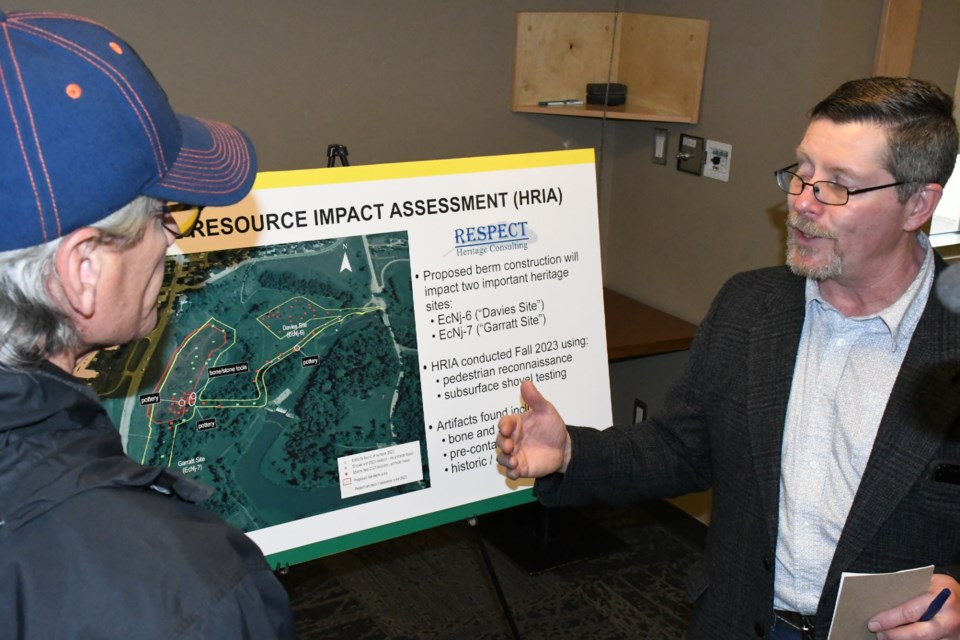Sections of Wakamow Valley contain a treasure trove of fascinating artifacts that archeologists continue to dig up, with one professional describing a location near a proposed construction zone as “a special site.”
Alan Korejbo, a registered professional archaeologist with Respect Inc. Heritage Consulting, which focuses on regulatory compliance and heritage resource impact assessments, conducted a review last fall near Ninth Avenue Southwest to determine whether any historic objects existed in the valley below.
The Ministry of Highways plans to install a dirt berm this fall to shore up the road and prevent any further soil erosion. It will then rebuild the road in 2025 once the slope slippage has ceased.
From his excavations, Korejbo found “a real hodgepodge” of artifacts, some dating to the 1960s, some from pre-contact times, and some allegedly dating back 3,000 years.
He then made several recommendations to the province after conducting the assessment, including having archaeologists monitor the area during the work, installing swamp mats to protect sensitive natural areas from heavy machinery and pursuing additional mitigative excavations this year.
“This is a special site. It’s (been) a special site anyway, even before this (project) … . There should be more work done,” Korejbo said on April 30 during an open house at the Events Centre.
“(Actually), I shouldn’t say that. When it’s in the ground, it’s safe for future generations,” he continued. “So, all archaeologists … want to find stuff, but really, our primary objective is supposed to be to save it and not dig it up.”
The area where Korejbo performed his shovel-deep excavations is a flood plain west of the Seventh Avenue Southwest bridge, south of Valleyview Drive, adjacent to Ninth Avenue Southwest/Highway 363 and flanked by the creek.
Using a systematic, common-sense approach, Korejbo dug in fields that became known as the Davies Site and the Garratt Site, named after their previous owners, Paul Davies and Bill Garratt.
“It’s like finding a needle in a haystack … ,” he said.
Davies found historical artifacts in his field in the 1950s and called the provincial archaeologist at the University of Saskatchewan to come see his findings.
“There was no (provincial archaeological) legislation till 1979 (or) 1980. So, he didn’t have to (call anyone),” said Korejbo.
Every shovel test that Korejbo conducted on or near the Davies site found an artifact, such as pieces of pottery or farmhouses, while he found a concentrated grouping of items on the Garratt Site, including pottery and bone or stone tools.
This area is a flood plain, so it’s natural for animal skeletons to wash up onto the shore, he said. However, he found “lots of bone” — especially from bison — that he thought indicated the presence of people.
Evidence from ground disturbances also indicates Black Bull situated his camp on the Davies Site in the 1800s, while there was a Metis “hotel” — a shack, really — from the 1840s and a Metis trail.
He was also told that a rail-type system allegedly ran through the area, which he found difficult to believe until he found a large railroad spike.
Korejbo thought it was interesting to find pottery buried 50 centimetres down, which is “really deep” since archaeologists usually find items near the surface. That depth is great, however, because the soil protects items until researchers excavate them.
“Before this project, the biggest piece of pottery I (ever) found was about the size of my pinky nail, so these are quite large and unique,” he said.
Some of the pottery pieces are well preserved and indicate — via carbonized material — the food people ate, he continued. A laboratory confirmed “what was on the menu” from the pieces he submitted.
“The only better way is through coprolites. And nobody wants to go there. That’s fossilized turds,” he chuckled.
This “unique pottery” may have been from the late 1700s or early 1800s and come from either southwestern Manitoba or central Missouri, making this the second-oldest site in Saskatchewan after Mortlach and Avonlea and one of only five locations in the province, Korejbo said.
He added that he spoke to the top pottery experts across the Prairies and learned they’re not even sure from where these items came.
“… it’s absolutely a rich site (and) it’s a very important site for Saskatchewan,” he added.




